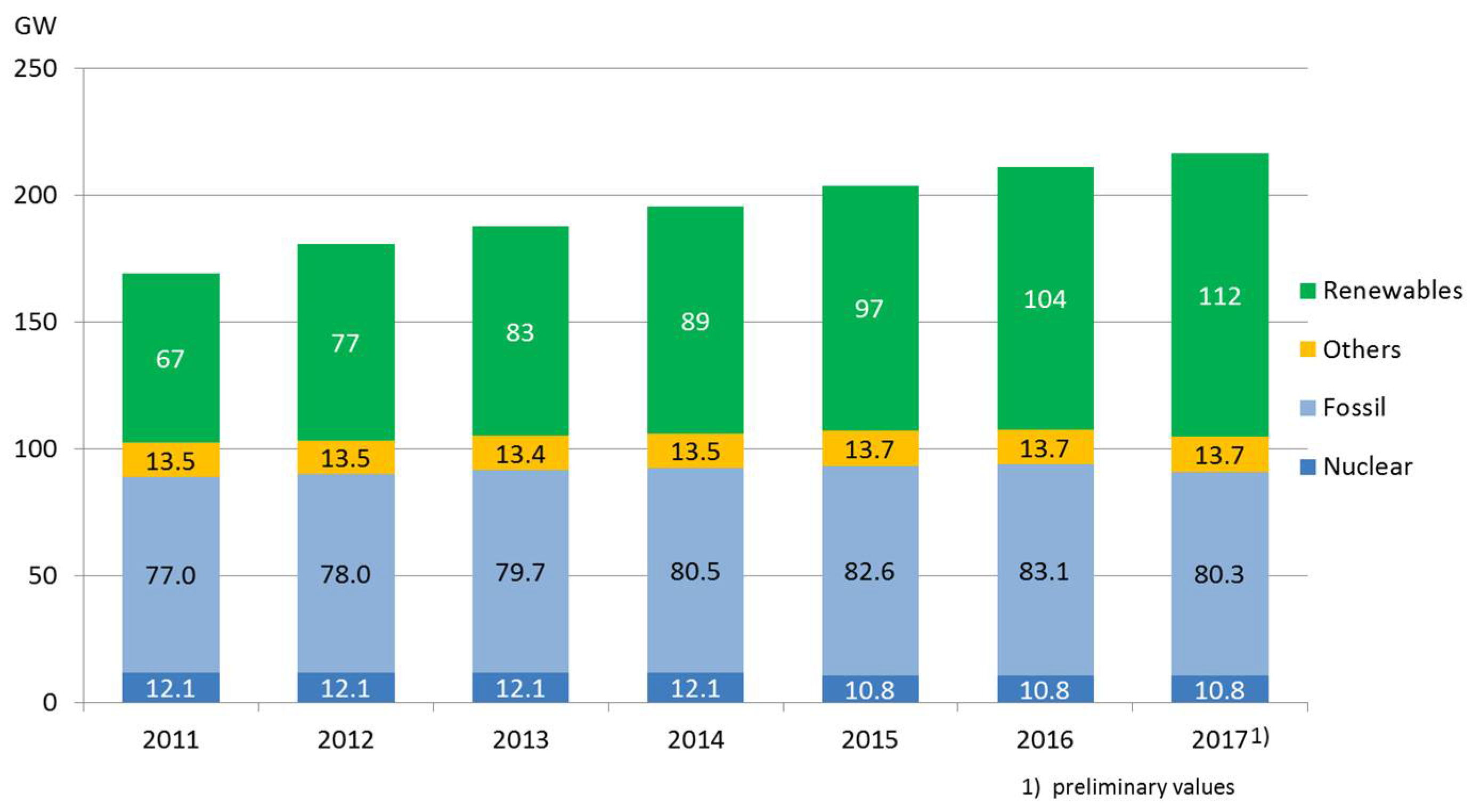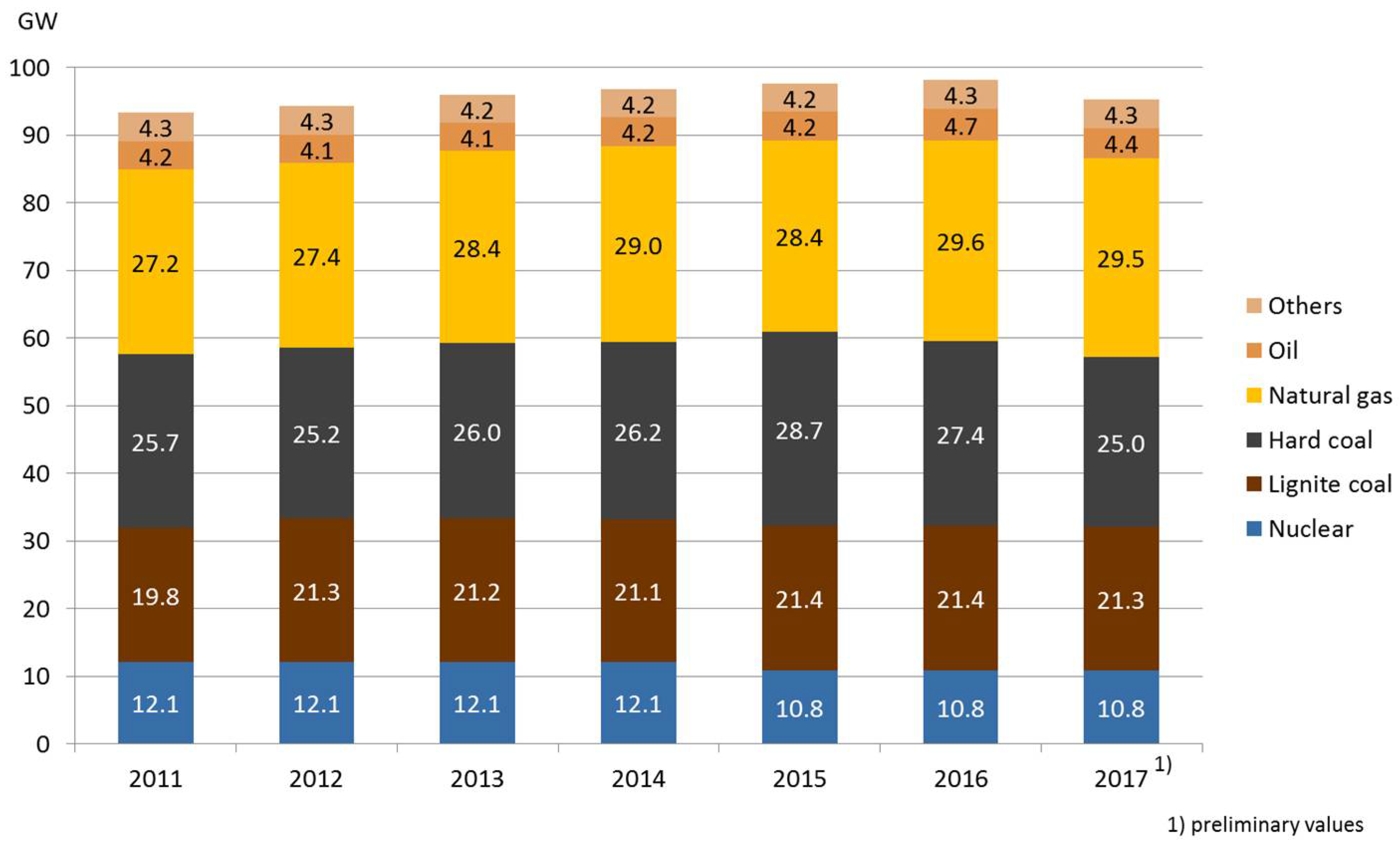The Future of Fossil Fired Power Plants in Germany—A Lifetime Analysis
Abstract
:1. Introduction
2. Germany’s Power Plant Fleet
3. Lifetime Assumptions in National Energy Projections
3.1. Evaluation of Lifetime Assumptions in Projections
3.2. Classification of Fleet Projections According to the Example of Coal-Fired Power Plants
3.2.1. Lignite Coal-Fired Power Plants
3.2.2. Hard Coal-Fired Power Plants
4. Ex Post Analysis
4.1. Plants Decommissioned between 1990 and 1999
4.2. Plants Decommissioned between 2000 and 2014
4.3. Federal Network Agency’s List of Power Plant Closure Notification
4.4. Results Comparison
5. Summary and Conclusions
Supplementary Materials
Author Contributions
Funding
Conflicts of Interest
Appendix A
| Study | Hard Coal | Lignite Coal | Natural Gas | Oil | Literature |
|---|---|---|---|---|---|
| GDP (1) Electricity 2013 | 50 | 50 | 45 | 50 | [46] |
| GDP Electricity 2014 | 50 | 50 | 45 | 50 | [28] |
| GDP Electricity 2025 (first draft) | [29] | ||||
| Scenario A | 50 | -(2) | 45 | 45 | |
| Scenario B | 40 | -(2) | 45 | 45 | |
| GDP Electricity 2025 | [42] | ||||
| Scenario A | 50 | 50 | 45 | 45 | |
| Scenario B | 45 | 45 | 40 | 40 | |
| Scenario C | 40 | 40 | 35 | 35 | |
| IZES 2015 projection | [8] | ||||
| Coal phase out scenarios | Depending on efficiencies and specific CO2-emissions and limited emissions caps (3) | - | - | ||
| DIW projection | [31] | ||||
| Coal phase out scenarios | Depending on efficiencies and specific CO2-emissions (4) | ||||
| Öko-Institut/ISI FhG 2014 | 45 | 45 | 30–40 | 30–35 | [47] |
| Öko-Institut/ISI FhG 2015 | 55 | 55 | 30–35 | 30–35 | [10] |
| AGORA | [4] | ||||
| Reference scenario | 50 | 40 | - | - | |
| Coal phase out scenarios | |||||
| until 2025 | >40 | - | - | ||
| 2026-2030 | 35–39 | - | - | ||
| 2031-2035 | 30–34 | - | - | ||
| 2036-2040 | 27–29 | - | - | ||
| >2040 | 27–29 | - | - | ||
| Forschungszentrum Jülich | Calculation based on life time consumption via operation hours and operation modes | [35] | |||
| Forschungszentrum Jülich | 35 (5) | 35 (5) | - | [33] | |
| Forschungszentrum Jülich | [34,48] | ||||
| Reference case | 45 | 50 | 35 | 35 | |
| Coal phase out | Model calculation | 35 | 35 | ||
| Policy scenarios VI | 45 | 50 | 25–50 | 30–35 | [7] |
| Greenpeace (8) | - | 39 (7) | - | - | [2] |
| BMWi Energiemärkte Report 1995 | 30–35 | [38] | |||
| BMWi Energiemärkte Report 1999 | Model calculation (6) | [39] | |||
| BMWi Referenz-prognose 2005 | A maximum technical lifetime (7) has been assumed, year of phase-out was calculated by using a model | [40] | |||
| BMWi Energie-prognose 2009 | No information available | [9] | |||
| Energy scenario for a national energy concept 2010 | No information available | [6] | |||
| BMWi Energie-referenzprognose 2014 | No information available | [5] | |||
| Folke, PhD Thesis 2000 | 50 | 50 | 30 (10) 35 (11) | - | [49] |
| ECOFYS | [32] | ||||
| Reference case | 49 (5),(7) | 47 (5),(7) | - | - | |
| Coal phase out | 39 (8),(3) | 36 (8),(3) | - | - | |
References
- BMU Klimaschutzplan 2050—Kabinettbeschluss vom 14. 2016. Available online: www.bmub.bund.de (accessed on 15 November 2016).
- Energy Brainpool. Auswirkungen Eines Partiellen Kohleausstiegs. Studie im Auftrag von Greenpeace e.V.: 2. 2015. Available online: http://www.energybrainpool.com/analyse/studienverzeichnis.html (accessed on 25 April 2018).
- Enervis Energy Advisors. Ein Kraftwerkspark im Einklang mit den Klimazielen. Handlungslücke, Maßnahmen und Verteilungseffekte bis 2020. Studie im Auftrag der Agora Energiewende. 2015. Available online: www.agora-energiewende.de (accessed on 25 April 2018).
- Enervis Energy Advisors. Der Klimaschutzbeitrag des Stromsektors—Entwicklungspfade für die deutschen Kohlekraftwerke und deren wirtschaftliche Entwicklung. Studie im Auftrag der Agora Energiewende. 2015. Available online: www.agora-energiewende.de (accessed on 25 April 2018).
- EWI; Prognos. GWS Entwicklung der Energiemärkte—Energiereferenzprognose. Studie im Auftrag des Bundesministeriums für Wirtschaft und Technologie, Projekt Nr. 57/12. 2014. Available online: https://www.bmwi.de/Redaktion/DE/Publikationen/Studien/entwicklung-der-energiemaerkte-energiereferenzprognose-endbericht.pdf?__blob=publicationFile&v=7 (accessed on 15 March 2018).
- EWI/gws/Prognos. Energieszenarien für ein Energiekonzept der Bundesregierung. Studie im Auftrag des BMWi, Projekt Nr. 12/10. 2010. Available online: http://www.ewi.uni-koeln.de/fileadmin/user_upload/Publikationen/Studien/Politik_und_Gesellschaft/2010/EWI_2010-08-30_Energieszenarien-Studie.pdf (accessed on 20 November 2017).
- Hansen, P.; Gorres, S.; Matthes, F.C. Politikszenarien für den Klimaschutz VI—Treibhausgas-Emissionsszenarien bis zum Jahr 2030; Schriften des Forschungszentrums Jülich, Reihe Energie und Umwelt, Band 203, Advances in Systems Analysis 5; Forschungszentrum Jülich GmbH: Jülich, Germany, 2014. [Google Scholar]
- Horst, J.; Leprich, U.; Luxenburger, M.; Klann, U.; Weber, A.; Zipp, A.; Klinski, S. Kraftwerks-Stilllegungen zur Emissionsreduzierung und Flexibilisierung des Deutschen Kraftwerksparks: Möglichkeiten und Auswirkungen. Studie der izesgGmbH im Auftrag des MWKEL des Landes Rheinland-Pfalz. 2015. Available online: http://www.izes.de/de/projekte/ (accessed on 26 March 2018).
- IER/rwi/ZEW. Die Entwicklung der Energiemärkte bis 2030 (Energieprognose 2009). Studie im Auftrag des BMWi Projekt Nr. 23/08. 2008. Available online: http://www.rwi-essen.de/media/content/pages/publikationen/rwi-projektberichte/PB_Energieprognose-2009.pdf (accessed on 20 October 2017).
- Öko-Institut; FhG-ISI. Klimaschutzszenario 2050—2. Runde Studie im Auftrag des BMU. 2015. Available online: https://www.oeko.de/oekodoc/2451/2015-608-de.pdf (accessed on 16 March 2018).
- Reitz, F.; Gerbaulet, C.; Kemfert, C.; Lorenz, C.; Pao-Yu, L.; von Hirschhausen, C. Szenarien einer nachhaltigen Kraftwerksentwicklung in Deutschland. Studie im Auftrag der Heinrich Böll Stiftung. DIW Berlin: Politikberatung kompakt 90. 2014. Available online: www.diw.de (accessed on 25 May 2018).
- Robinius, M.; Stein, F.; Schwane, A.; Stolten, D. A Top-Down Spatially Resolved Electrical Load Model. Energies 2017, 10, 361. [Google Scholar] [CrossRef]
- Farfan, J.; Breyer, C. Aging of European power plant infrastructure as an opportunity to evolve towards sustainability. Int. J. Hydrog. Energy 2017, 42, 18081–18091. [Google Scholar] [CrossRef]
- Farfan, J.; Breyer, C. Structural changes of global power generation capacity towards sustainability and the risk of stranded investments supported by a sustainability indicator. J. Clean. Prod. 2017, 141, 370–384. [Google Scholar] [CrossRef]
- García-Gusano, D.; Iribarren, D.; Dufour, J. Is coal extension a sensible option for energy planning? A combined energy systems modelling and life cycle assessment approach. Energy Policy 2018, 114, 413–421. [Google Scholar] [CrossRef]
- Johnson, N.; Krey, V.; McCollum, D.L.; Rao, S.; Riahi, K.; Rogelj, J. Stranded on a low-carbon planet: Implications of climate policy for the phase-out of coal-based power plants. Technol. Forecast. Soc. Chang. 2015, 90, 89–102. [Google Scholar] [CrossRef]
- Odenberger, M.; Johnsson, F. Achieving 60% CO2 reductions within the UK energy system—Implications for the electricity generation sector. Energy Policy 2007, 35, 2433–2452. [Google Scholar] [CrossRef]
- Bundesministerium für Wirtschaft und Energie (BMWi). Fünfter Monitoring-Bericht zur Energiewende—Die Energie der Zukunft Berichtsjahr 2015; Bundesministerium für Wirtschaft und Energie (BMWi): Berlin, Germany, 2016. Available online: https://www.bmwi.de/Redaktion/DE/Publikationen/Energie/fuenfter-monitoring-bericht-energie-der-zukunft.pdf?__blob=publicationFile&v=24 (accessed on 31 December 2016).
- Arbeitsgruppe Erneuerbare Energien-Stastitik (AGEE-Stat). Erneuerbare Energien in Zahlen. 2018. Available online: https://www.erneuerbare-energien.de/EE/Navigation/DE/Service/Erneuerbare_Energien_in_Zahlen/erneuerbare_energien_in_zahlen.html (accessed on 24 May 2018).
- Bundesnetzagentur. Monitoringbericht 2017. 2017. Available online: https://www.bundesnetzagentur.de/SharedDocs/Downloads/DE/Allgemeines/Bundesnetzagentur/Publikationen/Berichte/2017/Monitoringbericht_2017.pdf?__blob=publicationFile&v=3 (accessed on 24 May 2018).
- Markewitz, P.; Robinius, M.; Stolten, D. Energietransport und -verteilung. Brennstoff-Wärme-Kraft 2018, 70, 47–55. (In German) [Google Scholar]
- Arbeitsgemeinschaft Energiebilanzen (AGEB). Bruttostromerzeugung in Deutschland in Deutschland ab 1990 nach Energieträgern. Available online: https://www.ag-energiebilanzen.de/ (accessed on 24 May 2018).
- Bundesministerium für Wirtschaft und Energie (BMWi). Die Elektrizitätswirtschaft in der Bundesrepublik Deutschland im Jahre 1986—Statistischer Jahresbericht des Referats Elektrizitätswirtschaft im Bundesministeriums für Wirtschaft (BMWi). Elektrizitätswirtschaft 1987, 86, 805–871. [Google Scholar]
- Bundesministerium für Wirtschaft und Energie (BMWi). Die Elektrizitätswirtschaft in der Bundesrepublik Deutschland im Jahre 1989—Statistischer Jahresbericht des Referats Elektrizitätswirtschaft im Bundeministerium für Wirtschaft (BWMi). Elektrizitätswirtschaft 1990, 89, 1111–1195. [Google Scholar]
- Bundesministerium für Wirtschaft und Energie (BMWi). Die Elektrizitätswirtschaft in der Bundesrepublik Deutschland im Jahre 1990—Statistischer Jahresbericht des Referats Elektrizitätswirtschaft im Bundesministerium für Wirtschaft; VWEW-Verlag: Frankfurt am Main, Germany, 1992; p. 63.
- Bundesministerium für Wirtschaft und Energie (BMWi). Gesamtausgabe der Energiedaten—Datensammlung BMWi; Bundesministerium für Wirtschaft und Energie (BMWi): Berlin, Germany, 2018. Available online: https://www.bmwi.de/Redaktion/DE/Artikel/Energie/energiedaten-gesamtausgabe.html (accessed on 25 March 2018).
- Bundesnetzagentur Kraftwerksliste. Available online: https://www.bundesnetzagentur.de/DE/Sachgebiete/ElektrizitaetundGas/Unternehmen_Institutionen/Versorgungssicherheit/Erzeugungskapazitaeten/Kraftwerksliste/kraftwerksliste-node.html (accessed on 20 March 2017).
- Übertragungsnetzbetreiber. Szeanriorahmen 2013. 50Hertz, Amprion, TenneT TSO, TransnetBW (Genehmigt von der BNA am 30 August 2013). 2013. Available online: https://www.bundesnetzagentur.de/SharedDocs/Pressemitteilungen/DE/2012/120720_SzenariorahmenNEP2013.html (accessed on 25 April 2018).
- Übertragungsnetzbetreiber. Szenariorahmen für die Netzentwicklungspläne Strom 2015—Entwurf der Übertragungsnetzbetreiber. 50Hertz Transmission, Amprion, TenneT TSO, TransnetBW. 2014. Available online: https://www.netzausbau.de/home/de.html (accessed on 25 April 2018).
- Agora Energiewende. Elf Eckpunkte für Einen Kohlekonsens. Konzept zur Schrittweisen Dekarbonisierung des Deutschen Stromsektors. 2016. Available online: www.agora-energiewende.de (accessed on 25 April 2018).
- Reitz, F.; Gerbaulet, C.; Kemfert, C.; Lorenz, C.; Oei, P.-Y.; von Hirschhausen, C. Szenarien einer nachhaltigen Kraftwerksentwicklung in Deutschland. Studie im Auftrag der Heinrich-Böll Stiftung und der European Climate Foundation, DIW Berlin Politikberatung Kompakt 90. 2014. Available online: https://www.boell.de/de/2014/11/19/studie-szenarien-nachhaltige-kraftwerksentwicklung-deutschland (accessed on 16 March 2018).
- Klaus, S.; Beyer, C.; Jaworski, P. Allokationsmethoden der Reststrommengen nach dem Entwurf des Kohleausstiegsgesetzes. Studie im Auftrag der Greenpeace Deutschland e.V. 2012. Available online: www.greenpeace.de (accessed on 25 April 2018).
- Markewitz, P.; Nollen, A.; Th, P. Die Altersstruktur des westdeutschen Kraftwerksparks. Brennstoff-Wärme-Kraft 1998, 50, 38–42. (In German) [Google Scholar]
- Heinrichs, H.; Markewitz, P. A Coal Phase-out in Germany—Clean, Efficient and Affordable? Energy Procedia 2015, 75, 2541–2547. [Google Scholar] [CrossRef]
- Markewitz, P.; Nollen, A.; Vögele, S. German Power Plants: A Market Potential for the Plant Construction Sector? VGB PowerTech 2002, 82, 28–31. [Google Scholar]
- Meinke, S. Modellierung thermischer Kraftwerke vor dem Hintergrund steigernder Dynamikanforderungen Aufgrund Zunehmender Windenergie- und Photovoltaikeinspeisung. Ph.D. Thesis, Universität Rostock, Fakultät Maschinbau und Schiffstechnik, Rostock, Germany, 2012. (In German). [Google Scholar]
- Nollen, A. Lebensdaueranalysen von Kraftwerken der Deutschen Elektrizitätswirtschaft. Ph.D. Thesis, RWTH Aachen, Aachen, Germany, 2002. (In German). [Google Scholar]
- Prognos AG. Die Energiemärkte Deutschlands im Zusammenwachsenden Europa—Perspektiven bis Zum Jahr 2020 (Energieeport II)—Studie im Auftrag des Bundesministeriums für Wirtschaft; Schäffer-Poeschel Verlag für Wirtschaft: Stuttgart, Germany, 1995; p. 647. [Google Scholar]
- Prognos AG; EWI. Die Längerfristige Entwicklung der Energiemärkte im Zeichen von Wettbewerb und Umwelt (Energiereport III), Studie im Auftrag des BMWi; Schäffer-Poeschel Verlag: Stuttgart, Germany, 1999; p. 492. [Google Scholar]
- EWI/Prognos. Die Entwicklung der Energiemärkte bis zum Jahr 2030—Energiewirtschaftliche Referenzprognose; Oldenbourg Industrieverlag München: München, Germany, 2005. [Google Scholar]
- Bundesministerium für Wirtschaft und Energie (BMWi). Energiekonzept für eine Umwelt Schonende, Zuverlässige und Bezahlbare Energieversorgung; Bundesministerium für Wirtschaft und Technologie (BMWi): Berlin, Germany, 2010. Available online: http://www.bmwi.de/BMWi/Navigation/Service/publikationen,did=360808.html (accessed on 25 April 2018).
- Bundesnetzagentur (BNetzA). Genehmigung des Szenariorahmen 2025 für den NEP Strom 2025 Sowie O-NEP 2025; Bundesnetzagentur (BNetzA): Bonn, Germany, 2015. Available online: www.netzausbau.de (accessed on 21 March 2018).
- Markewitz, P.; Vögele, S. Kraftwerksüberkapazität in Deutschland. Energiewirtschaftliche Tagesfragen 2002, 52, 36–39. (In German) [Google Scholar]
- Bundesnetzagentur Liste der Kraftwerksstilllegungsanzeigen vom. 2017. Available online: https://www.bundesnetzagentur.de/DE/Sachgebiete/ElektrizitaetundGas/Unternehmen_Institutionen/Versorgungssicherheit/Erzeugungskapazitaeten/KWSAL/KWSAL_node.html (accessed on 5 April 2017).
- Heinz, B.; Graeber, M.; Praktiknjo, A.J. The diffusion process of stationary fuel cells in a two-sided market economy. Energy Policy 2013, 61, 1556–1567. [Google Scholar] [CrossRef]
- Übertragungsnetzbetreiber. Szenariorahmen für den Netzentwicklungsplan Strom 2013—Entwurf; Übertragungsnetzbetreiber (50Hertz, Amprion, TenneT TSO, TransnetBW): Stuttgart, Germany, 2012. [Google Scholar]
- Öko-Institut; FhG-ISI. Klimaschutzszenario 2050. Studie im Auftrag des BMU. 2014. Available online: www.oeko.de (accessed on 25 April 2018).
- Heinrichs, H.U.; Markewitz, P. Long-term impacts of a coal phase-out in Germany as part of a greenhouse gas mitigation strategy. Appl. Energy 2017, 192, 234–246. [Google Scholar] [CrossRef]
- Folke, C. Minderung der Kohlendioxidemissionen Durch Erneuerung Vorhandener Kohlekraftwerke in der Europäischen Union und Dadurch Verursachte Kosten; Fortschritt-Berichte VDI, Reihe 6 Energietechnik, Nr. 439; VDI-Verlag: Düsseldorf, Germany, 2000. [Google Scholar]
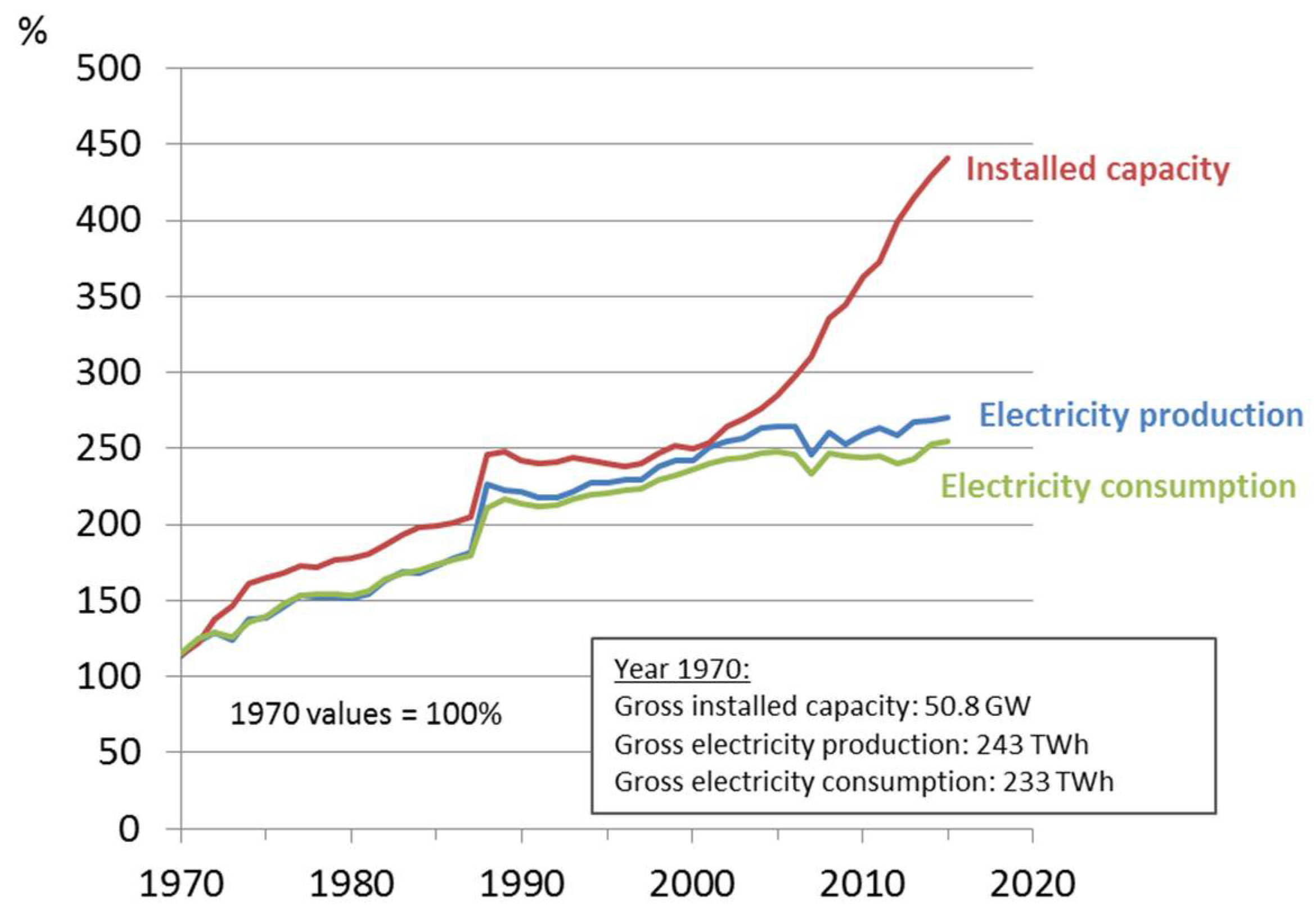
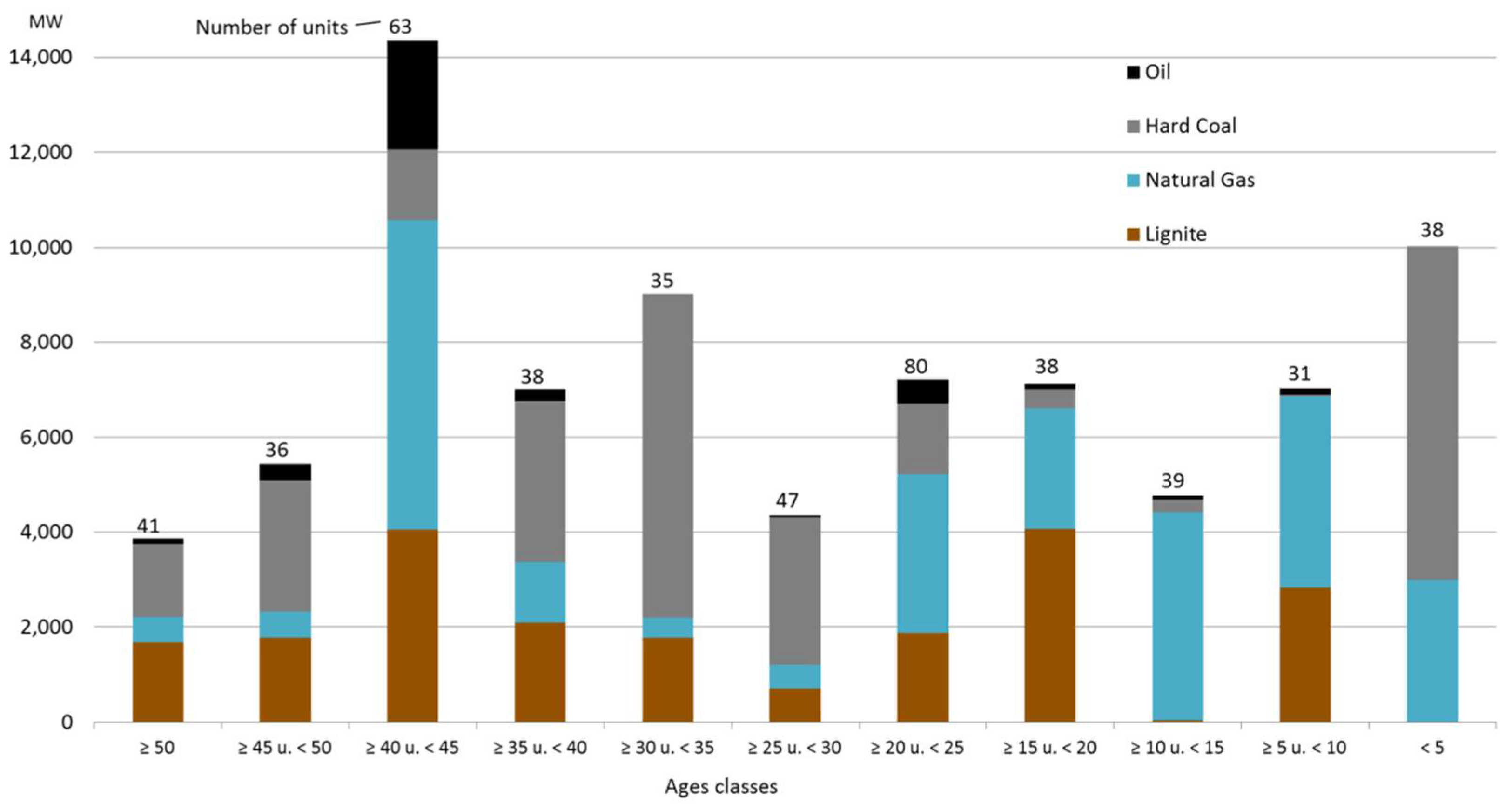
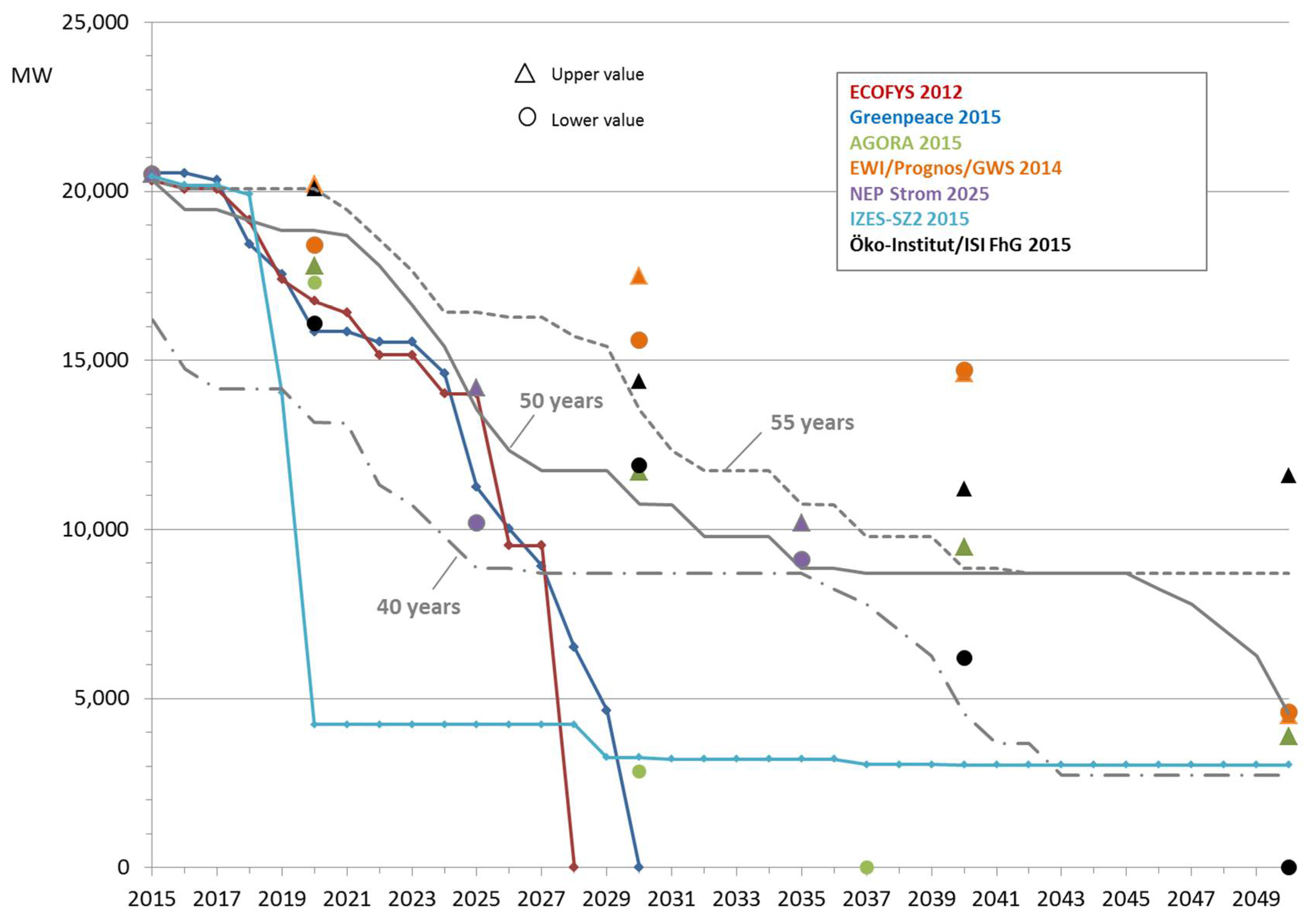
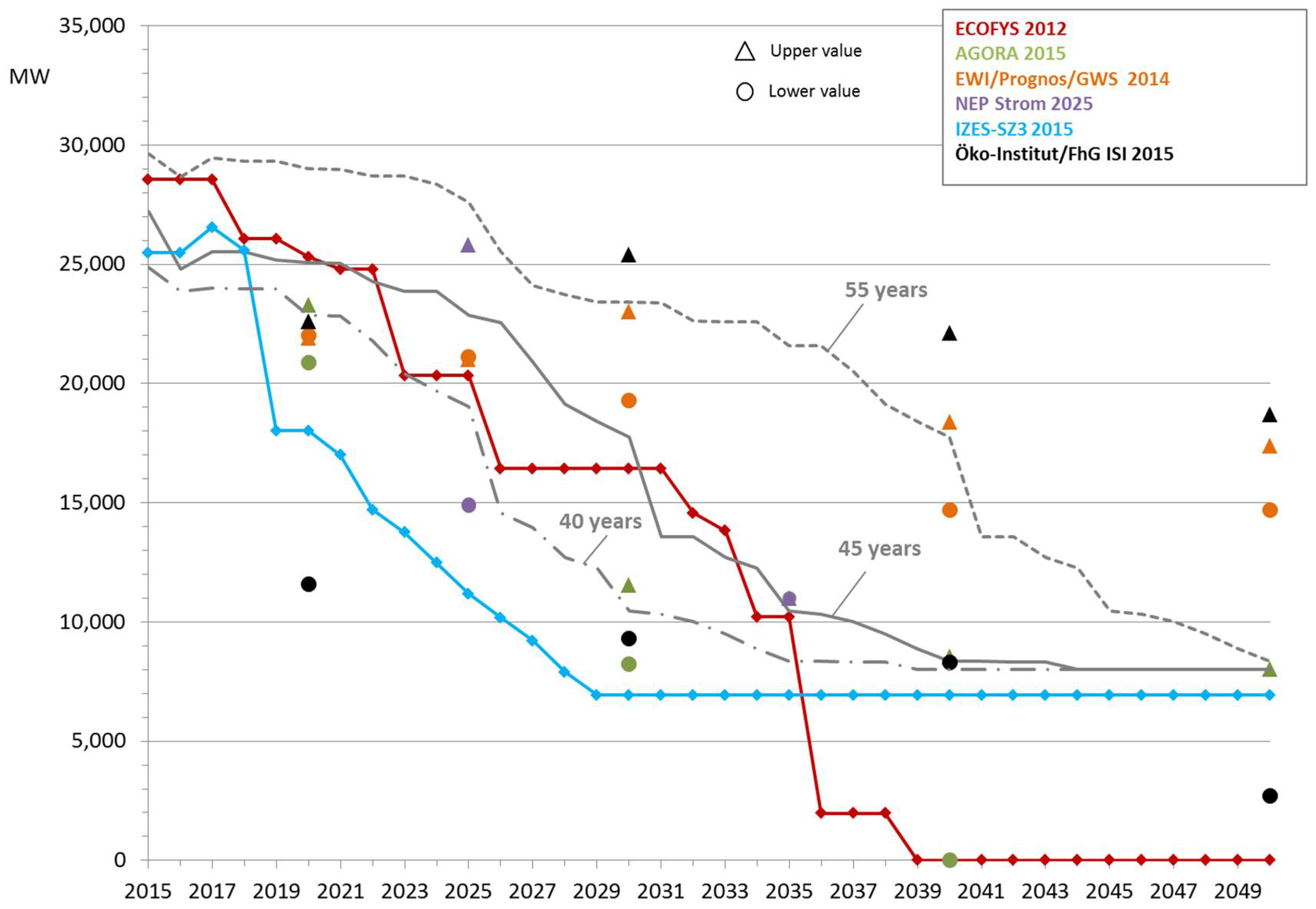
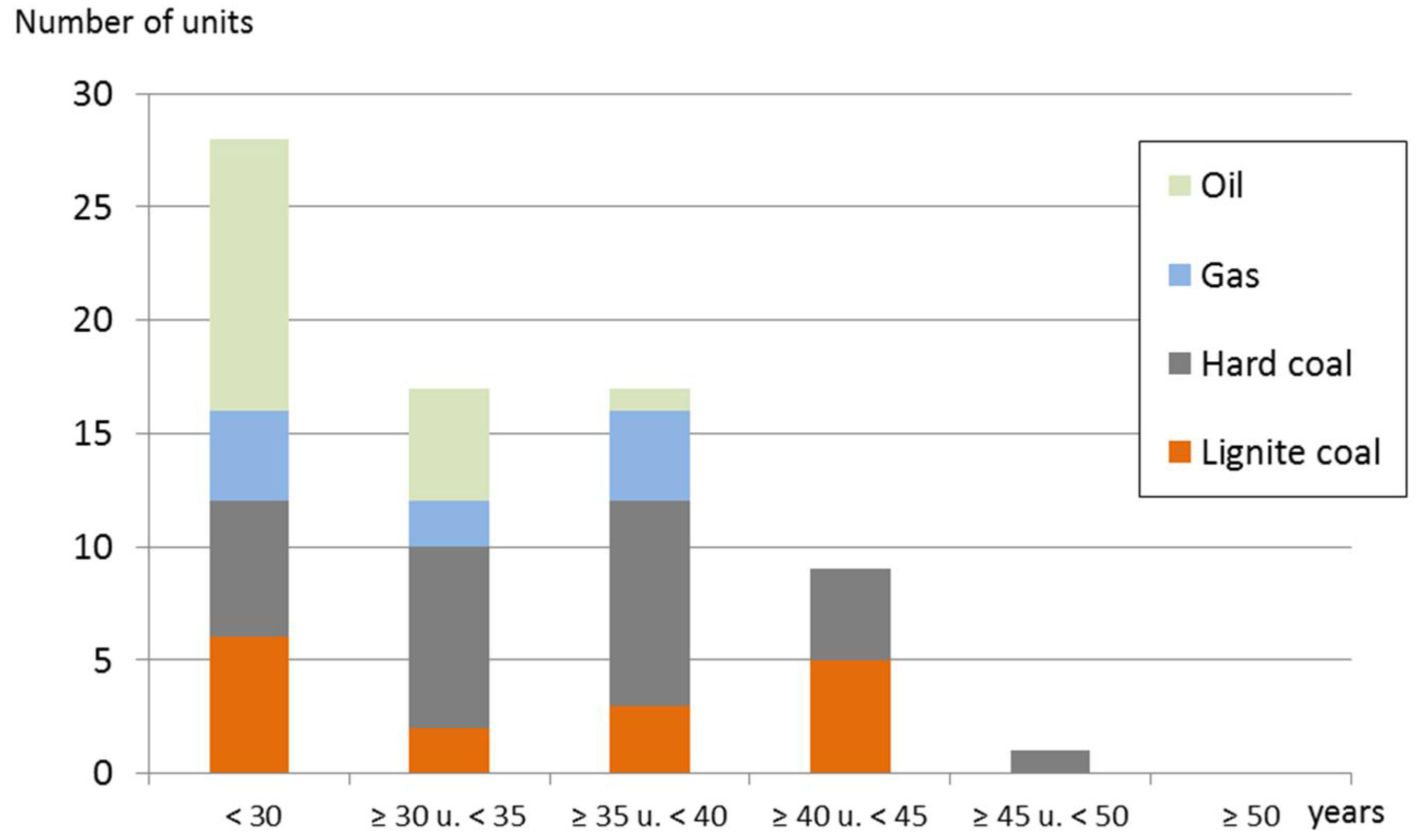
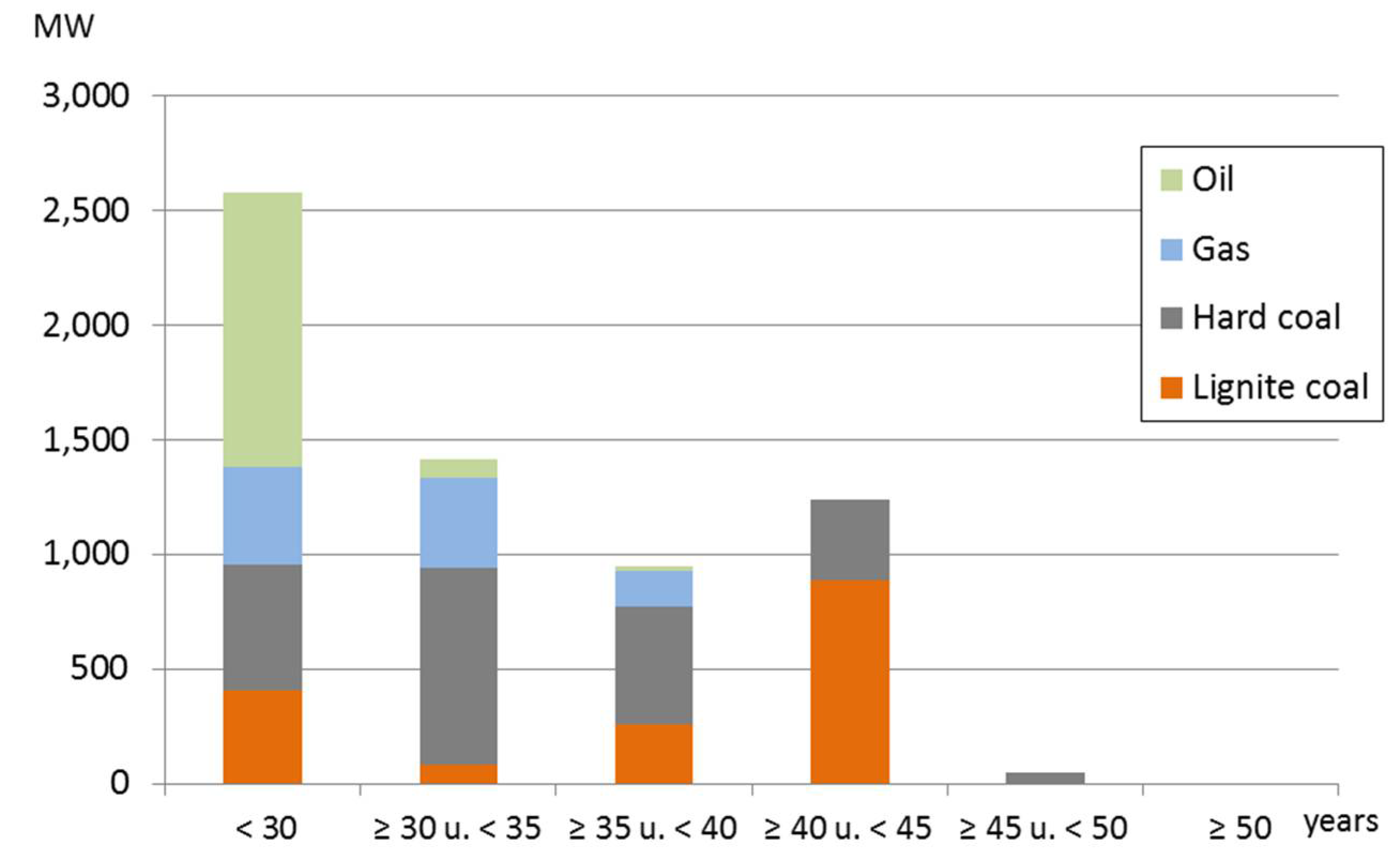
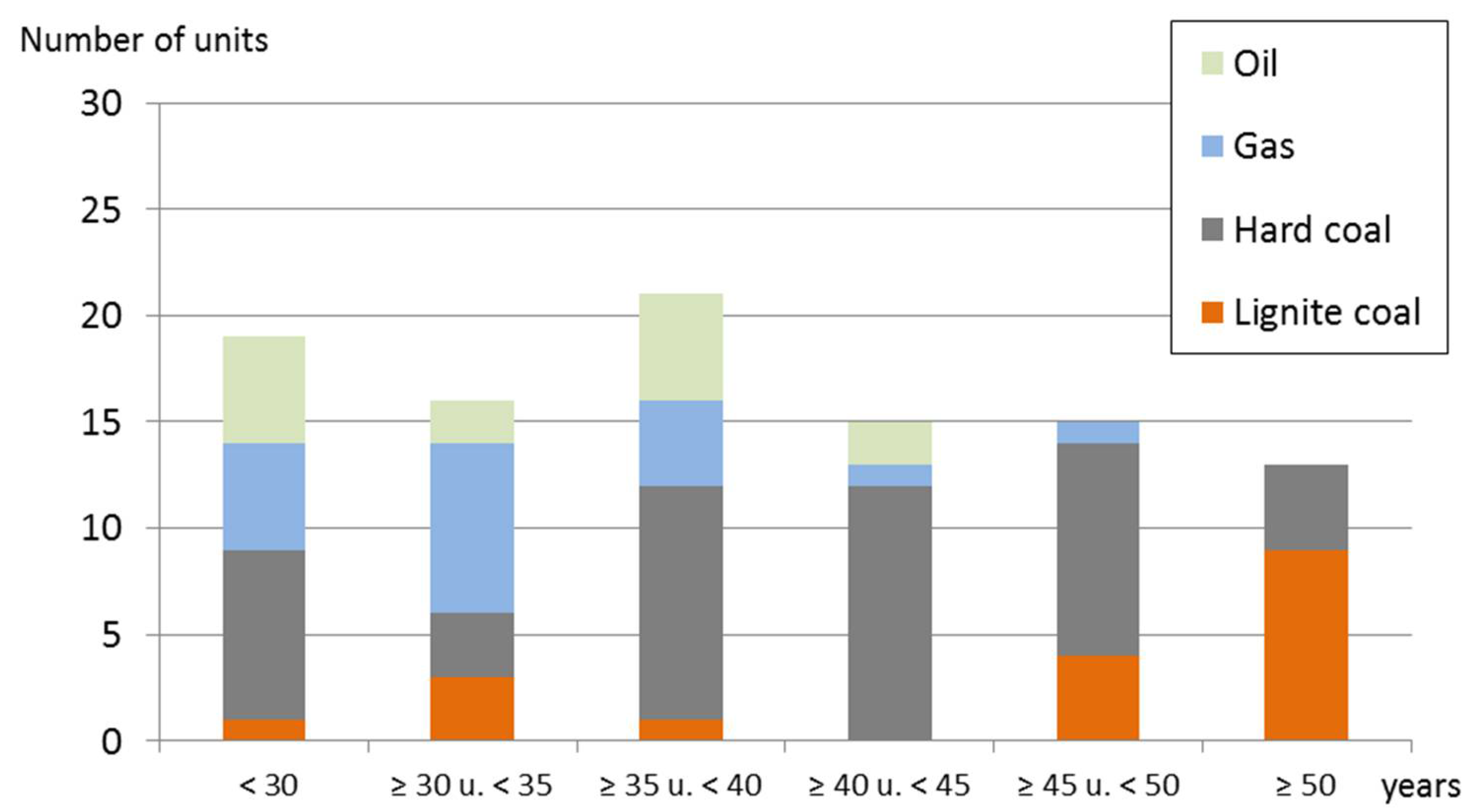
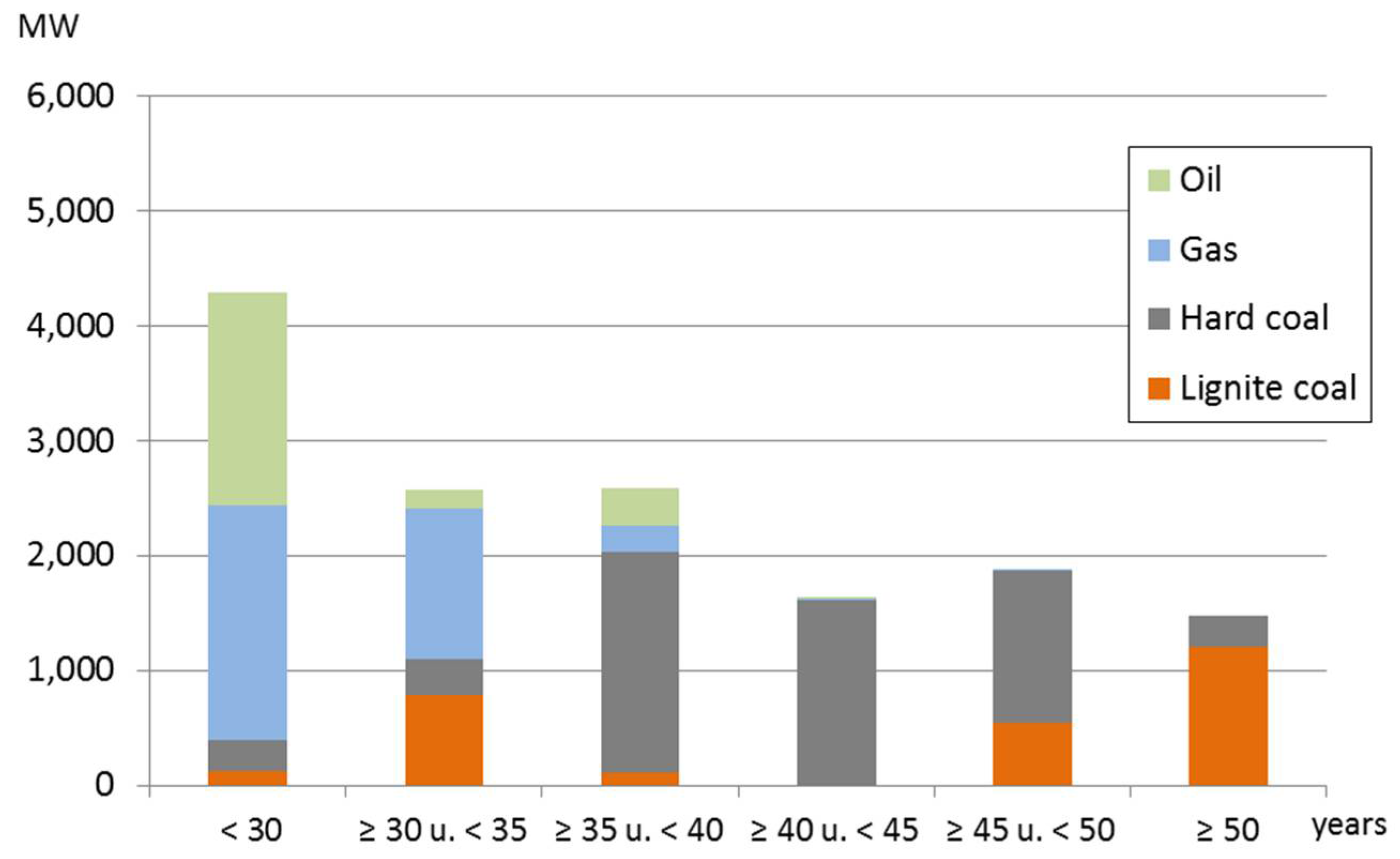
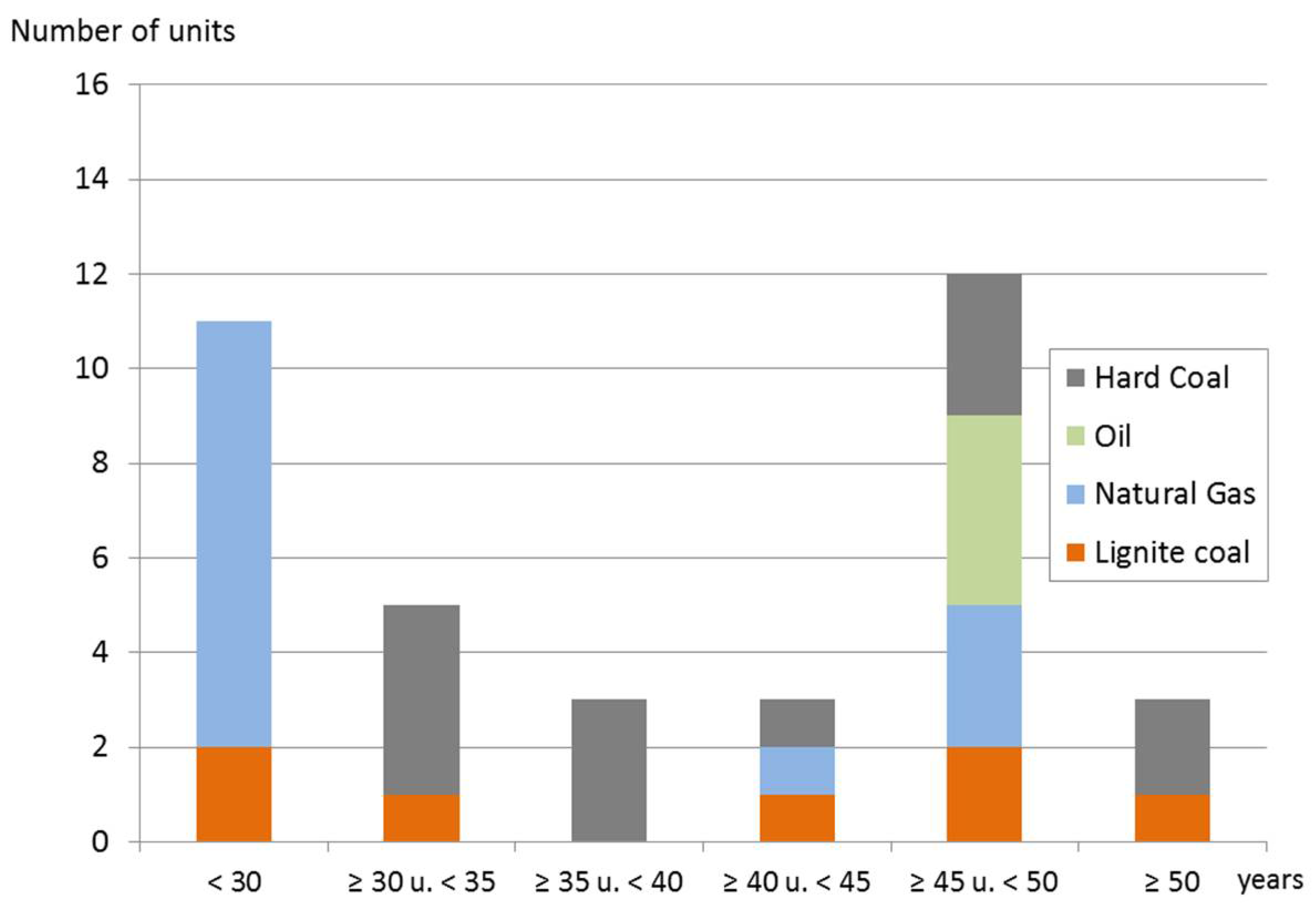
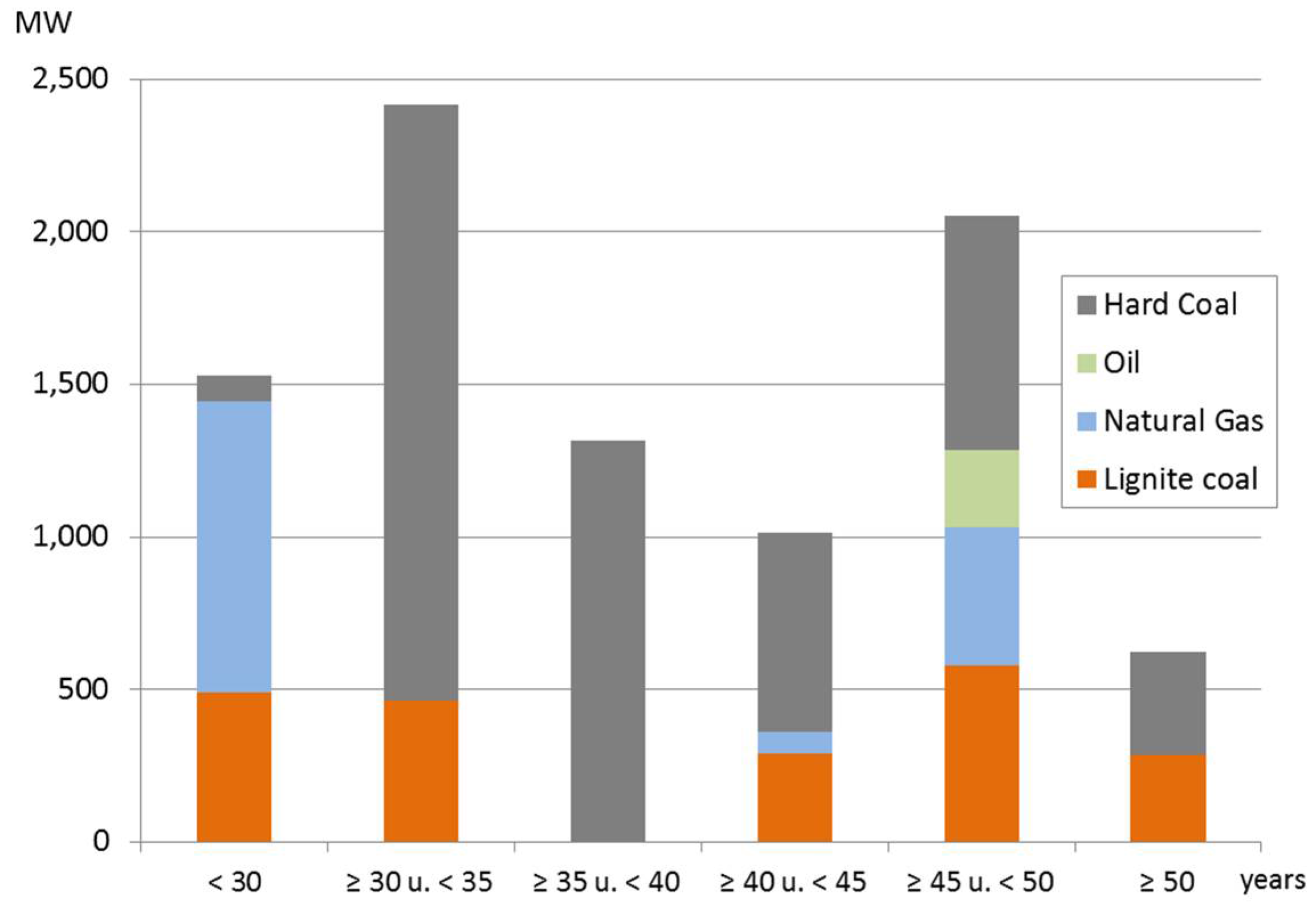
| Energy Sources | Electricity Production (TWhGross) | Share of Total Electricity Production (%) | Capacity (GWNet) | Share of Total Installed Capacity (%) |
|---|---|---|---|---|
| Lignite coal | 147.5 | 22.5 | 21.3 | 9.8 |
| Hard coal | 92.6 | 14.1 | 25 | 11.5 |
| Natural gas | 86.5 | 13.2 | 29.5 | 13.5 |
| Oil | 5.9 | 0.9 | 4.4 | 2.0 |
| Nuclear | 76.3 | 11.7 | 10.8 | 5.0 |
| Wind | 106.6 | 16,3 | 55.8 | 25.6 |
| PV | 39.9 | 6.1 | 42.4 | 19.5 |
| Biomass | 45.5 | 6.9 | 7.8 | 3.6 |
| Energy Sources | Age (Weighted with Capacity) | Age (Weighted with Number of Units) |
|---|---|---|
| Lignite coal | 30.4 | 32.9 |
| Hard coal | 27.3 | 32.9 |
| Gas | 22.8 | 24.1 |
| Oil | 37.5 | 34.4 |
| Age | Lifetime of Decommissioned Power Plants | |||
|---|---|---|---|---|
| Energy Source | Existing Stock | ≥1990 and ≤1999 | ≥2000 and ≤2014 (1) | Scheduled for Decommissioning § 13a EnWG |
| Lignite | 30.4 | 36.3 | 43.3 | 39.5 |
| Hard coal | 27.3 | 32.9 | 40.9 | 38.6 |
| Gas | 22.8 | 30.5 | 29.5 | 27.5 |
| Oil | 37.5 | 26.2 | 29.5 | 47.5 |
| Age | Lifetime of Decommissioned Power Plants | |||
|---|---|---|---|---|
| Energy Source | Existing Stock | ≥1990 and ≤1999 | ≥2000 and ≤2014 (1) | Scheduled for Decommissioning § 13a EnWG |
| Lignite | 32.9 | 33.9 | 45.1 | 38.9 |
| Hard coal | 32.9 | 35.1 | 39.5 | 41.0 |
| Gas | 24.1 | 31.2 | 32.7 | 29.0 |
| Oil | 34.4 | 32.3 | 32.9 | 47.5 |
© 2018 by the authors. Licensee MDPI, Basel, Switzerland. This article is an open access article distributed under the terms and conditions of the Creative Commons Attribution (CC BY) license (http://creativecommons.org/licenses/by/4.0/).
Share and Cite
Markewitz, P.; Robinius, M.; Stolten, D. The Future of Fossil Fired Power Plants in Germany—A Lifetime Analysis. Energies 2018, 11, 1616. https://doi.org/10.3390/en11061616
Markewitz P, Robinius M, Stolten D. The Future of Fossil Fired Power Plants in Germany—A Lifetime Analysis. Energies. 2018; 11(6):1616. https://doi.org/10.3390/en11061616
Chicago/Turabian StyleMarkewitz, Peter, Martin Robinius, and Detlef Stolten. 2018. "The Future of Fossil Fired Power Plants in Germany—A Lifetime Analysis" Energies 11, no. 6: 1616. https://doi.org/10.3390/en11061616
APA StyleMarkewitz, P., Robinius, M., & Stolten, D. (2018). The Future of Fossil Fired Power Plants in Germany—A Lifetime Analysis. Energies, 11(6), 1616. https://doi.org/10.3390/en11061616






